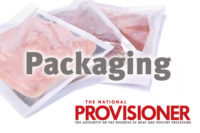PACK EXPO Las Vegas is almost upon us. Helping to set the stage for an impactful experience for all expo attendees, Tom Egan, vice president of Industry Services for PMMI, the Association for Packaging and Processing Technologies, shares some thoughts about the packaging marketplace and how innovation is powering change in the industry.
attendees, Tom Egan, vice president of Industry Services for PMMI, the Association for Packaging and Processing Technologies, shares some thoughts about the packaging marketplace and how innovation is powering change in the industry.
How can meat processors approach more sustainable packaging?
Meat processors constantly consider safety, market appeal, performance, cost and machinability as part of their product packaging. As interest in sustainable packaging approaches have grown, brand owners also must balance distribution requirements, material availability, and overall environmental impact. This requires a dialogue among stakeholders about packaging design, material choices, and end-of-life disposal options.
A circular economy can be achieved by focusing on how best to invest in recycling and composting infrastructure across the U.S. and tying that dialogue to what is happening with packaging design and the multiple variables packaging designers must juggle. Success will depend on how well members of the packaging value chain understand each other’s challenges and opportunities.
Another approach is to consider alternate product packaging methods to those currently in use. An August 2023 article in PMMI’s ProFood World magazine describes a Tyson pilot to investigate consumer acceptance of flow-wrap packs for case-ready beef. Tyson’s expectation is that this will reduce plastic used over 50% compared to the current product packaging. It also provides additional benefits including greater product visibility.
How do new packaging innovations impact food safety?
As discussed, there are constant, incremental – and sometimes broad – packaging innovations. Each plays a role in fulfilling the many demands placed on packaging – promote the product; protect it; provide information on proper, safe use; ingredients; handle through traditional distribution channels or e-commerce; provide information on disposal. In all cases, the packaging must support safe storage and handling of the food to the point of use by the customer.
What new packaging innovations are optimizing shelf life for meat products?
With increasingly stringent health and safety legislation, and producers looking to increase the shelf life of their products, it has never been more important for packaging to be closed and sealed correctly, according to the 2022 PMMI State of the Industry, US Packaging Machinery Report,” published by PMMI Business Intelligence, a division of PMMI, The Association for Packaging and Processing Technologies. Good seals are essential to package integrity and freshness preservation.
As meat producers transition to more sustainable materials, it’s important to select wrapping and form-fill-seal equipment that’s flexible enough to achieve good seals regardless of whether the substrate is downgauged, or offers some other sustainability feature. Seal integrity requires optimization of heat, pressure, and dwell time and/or the ability to run cohesive material. Offline testing of samples pulled periodically from the line or 100% inline inspection provides assurance of seal quality. The most advanced machines monitor heat, pressure, and dwell time and adjust those parameters as needed.
Sometimes seal integrity alone is not sufficient to maintain shelf life. Barrier materials are needed to protect the product from oxidation, water loss or gain, and microbial growth. Oxygen and moisture barriers can be provided by material thickness, a barrier layer or coating, or metallizing. For multi-serve products, resealability can help maintain product freshness after the package is opened. Resealability options include press-to-close or slider zippers, twist ties, and peel/reseal labels/flaps.
How can protein producers implement packaging trends and innovations into their operations?
Packaging lines must be flexible enough to handle a growing array of SKUs ranging from single-serve to variety packs while also addressing retailer demands for exclusive packaging variations and the expanding use of omnichannel approaches, a segment for all types of food.
Given how often product runs change and packaging formats can change, machine flexibility is key. Rapid changeover is essential as are machine designs that can be adapted to handle new materials that arrive in the marketplace, according to “Key Challenges for Packaging and Processing Operations,” a white paper based on discussions at PMMI’s Top to Top Summit in 2021.
Automation can offset labor constraints and also plays a role in improving productivity and efficiency, increasing line speed, and reducing safety concerns.
Prime reasons for introducing new packaging styles and adopting innovations includes the resulting ability to boost productivity by reducing downtime, human error, and waste; increasing flexibility; plus improving sustainability, ergonomics, and worker safety;
A variety of tactics can be used to increase productivity. Shaping the Future of Packaging Operations, a report developed from PMMI’s 2022 Top to Top Summit, reveals how CPG firms boost productivity:
- 60% use data collection to show the long-term picture for operational improvement
- 57% adopt automation to reduce labor needs
- 44% integrate cameras inside equipment to detect problems
- 38% use augmented reality
- 32% incorporate YouTube videos in the human-machine interface (HMI).
With the demand for more sophisticated systems, OEMs are designing machines that can trade data with the cloud and minimize downtime. Downtime reduction strategies include better availability of parts, built-in flexibility to handle multiple sizes and packaging formats, and toolless disassembly for efficient cleaning and changeover. Enhanced HMIs offer step-by-step changeover and maintenance instructions.
Clean-in-place (CIP) designs also help boost productivity and provide a safer working environment. Efficient cleaning is vitally important when changing over ingredients, particularly if allergens are involved, and plays an essential role in maximizing uptime, especially if CIP cycles can be scheduled when the line is scheduled to be down anyway. Automating the process saves time, frees personnel from a difficult manual task, and limits the involvement of operators on the line, thereby meeting the highest hygiene standards.

.png?height=96&t=1647275041&width=96)





